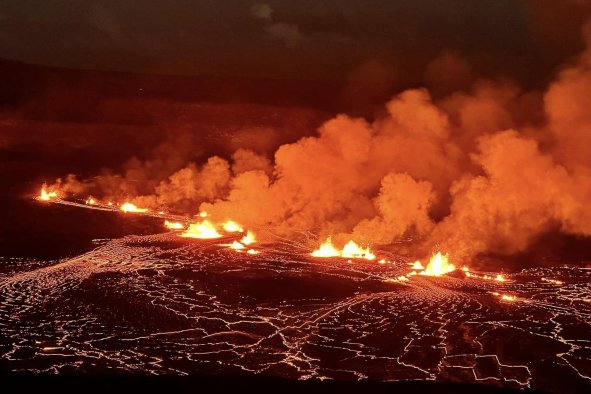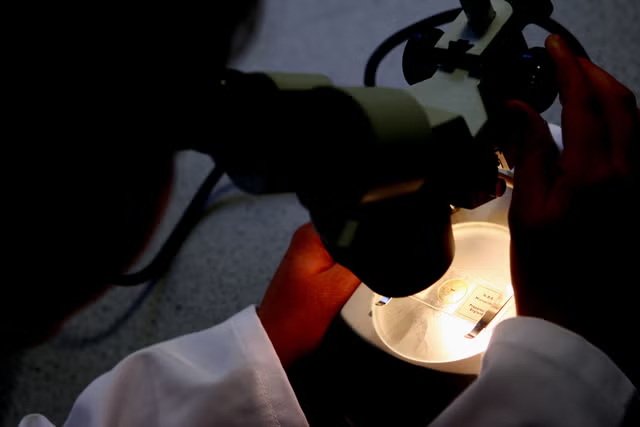Paleontologists have made an "amazing" fossil discovery in Australia that has shed new light on a giant and enigmatic prehistoric goose-like bird.
A team from Flinders University in Australia uncovered a nearly complete fossil skull of the "giga-goose," Genyornis newtoni—a flightless species that went extinct around 45,000 years ago—a study published in the journal Historical Biology reports.
This species was first described in 1896. But despite being known for more than a century, the only skull of the species recorded prior to the latest study was reported in 1913.
Unfortunately for researchers, this skull was heavily damaged with little of the original bone remaining. The remains that were preserved consisted of a "mass of broken fragments...[that] had suffered such great distortion from pressure affecting it laterally that anything approaching a satisfactory reconstruction was quite impossible," the original 1913 description reads.
As a result, paleontologists had not been able to obtain much information about the shape and structure of the skull, hampering researchers' understanding of the species' appearance, behavior and evolutionary relationships. Regardless of the fact that the 1913 skull was heavily damaged, the original description has formed the basis of all reconstructions of the species, leading to misconceptions regarding what it really looked like—particularly with regards to certain features, such as the shape of the upper bill.
But after more than a century, researchers have finally discovered multiple skull elements of G. newtoni, revealing its true appearance while also providing important new data about the species. The skull fossils were uncovered during a series of expeditions conducted by the Flinders University Palaeontology Lab to the saline dry beds of Lake Callabonna—a remote region of island South Australia.
"We knew that there was such little information known about the skull of Genyornis newtoni but that there was a lot of potential for better understanding this species if we could look at one," Flinders researcher and study lead author Phoebe McInerney told Newsweek.
The latest study was primarily based on one "key" skull that is almost complete, with all of the small bones still joined—or "in articulation" as paleontologists say.
"This was an amazing specimen but because it was all in articulation, we couldn't see all sides of each small bone," McInerney said. "So, we used the few other skull bones, such as an isolated upper beak, that had been found separately as well to get a more complete look at all aspects of the skull."
The latest study has revealed that the skull features a massive braincase, large upper and lower jaws and an unusual casque (a type of bony formation seen in some birds) on the top of its head. The upper beak, in particular, has a surprising shape, differentiating G. newtoni from even its closest relatives, which are otherwise fairly similar.
"Genyornis newtoni had a tall and mobile upper jaw like that of a parrot but shaped like a goose, a wide gape, strong bite force, and the ability to crush soft plants and fruit on the roof of their mouth," McInerney said in a press release.
Some aspects of the skull bear similarities to those of certain birds in the waterfowl group, namely, the South American screamers and the Australian magpie goose, suggesting a close evolutionary relationship.
"The exact relationships of Genyornis within this group have been complicated to unravel, however, with this new skull we have started to piece together the puzzle which shows, simply put, this species to be a giant goose," McInerney said.
The new evidence indicates that Dromornithidae (the avian family that G. newtoni belongs to) should be reclassified as a type of waterfowl—an order of birds that includes ducks, geese and swans.
"Something that we did not expect...was the presence of features which are associated with feeding in water, because the dromornithids were thought to be arid adapted birds, but here we were shown that they likely lived in a relied on semiaquatic habitats," McInerney told Newsweek.
"The disappearance of these habitats across central Australia and periods of drought, were likely contributing factors to the extinction of these birds from this region."
As part of the research, the team created a scientifically accurate reconstruction of the species, based on the fossils and comparisons with modern birds.
"We were particularly excited to discover the first fossil upper bill of Genyornis—for the first time we could put a face on this bird, one very different to any other bird, yet like a goose," Flinders researcher and study author Trevor Worthy said in the press release.
Do you have an animal or nature story to share with Newsweek? Do you have a question about paleontology? Let us know via science@newsweek.com.
Disclaimer: The copyright of this article belongs to the original author. Reposting this article is solely for the purpose of information dissemination and does not constitute any investment advice. If there is any infringement, please contact us immediately. We will make corrections or deletions as necessary. Thank you.



